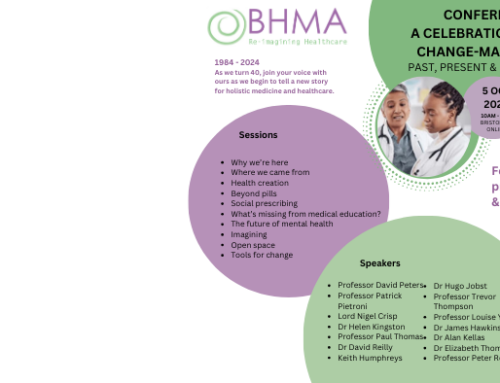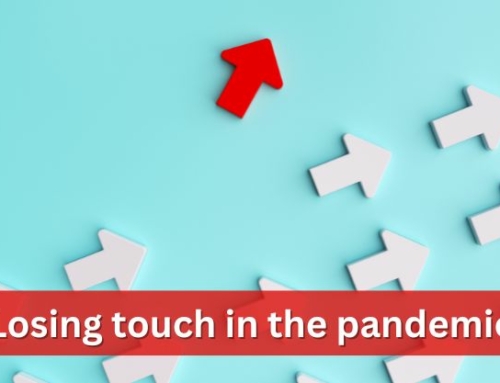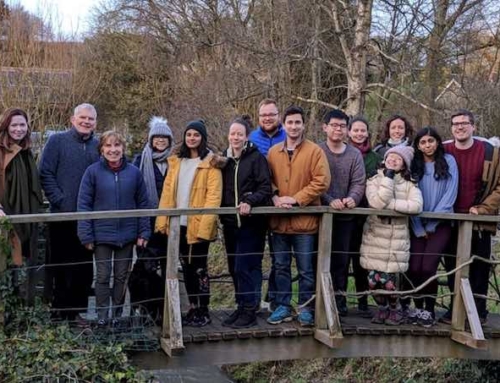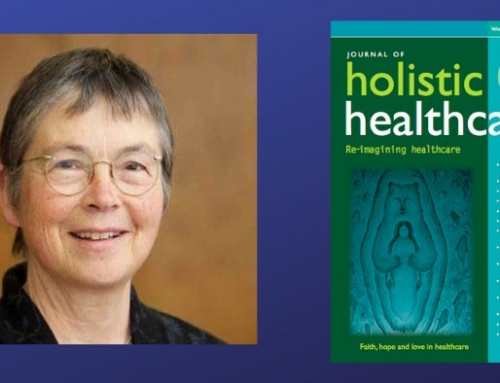Mrs Chowdry, an 81-year-old widow, notices the smell of blossom as she walks up the path. She can hear a group of people laughing in the Living Well practice kitchen as they learn how to make cordial from the flowers they’ve picked on their weekly walk, led by a patient volunteer.At the welcome desk, she’s greeted by a health navigator, measures her own blood pressure – nice and low – and sits down to read Poems in the Waiting Room. She looks forward to picking up her quarterly copy, and afterwards sharing it with an elderly neighbour, who she met at Pilates for Pensioners. The waiting room is looking fresh, with a bright new Five Ways to Wellbeing display, and a young mother is using the exercise bike while she waits for her postnatal check, her baby asleep in its pram.Mrs Chowdry is here for a medication review. She had her blood results sent to her mobile phone. It’s been adapted for her arthritic fingers, and she finds it a really useful way to get answers to her questions and communicate with family, friends and her long-term conditions nurse. The text message sent out by the practice about this appointment included some simple questions to help her make the most of her time with her GP. She feels she’s doing pretty well, especially after going to Fun Food for Health classes run by local sixth form science students helped by the community diabetes champion. She was bored with cooking the same things for herself every week, and is glad of new recipes and new friends to try them out on. But she’d like to take fewer tablets and she’s worried about feeling a bit wobbly at times…Dr Simon, her GP, is feeling ready for his first patient. He has cycled to work along the Green City cycle route, avoiding traffic jams and arriving in time for a whole team breakfast, organised by the practice manager who has recently run a mindfulness course. It was Simon’s turn to bring the bread as he’d surprised colleagues by taking up baking: kneading dough, he found, was an excellent way to work off frustrations with the NHS, and much better than kicking the cat. They also shared some of the first raspberries from the community garden, sited on a previously derelict plot of land behind the practice.Simon’s relationship with Mrs Chowdry has evolved over several years. He used to feel his irritable bowel stirring up at the prospect of morning surgery dragging on interminably. Back then he was always glad that she was happy simply to listen to what he had to say, accept her prescription, and leave. As far as he was concerned ‘shared decision-making’ was a load of politically correct twaddle, wasting time better spent on improving QOF achievement to maximise practice income. But he had to admit that things had changed after the social prescribing training. He found he was enjoying being a GP again, and that somehow patients like Mrs C seemed to have changed the way they talked to him too; he didn’t feel so responsible for everything and could even enjoy a joke or two. He felt a glow of pride in statistics showing how locality numbers for A&E attendances and admission rates had fallen by abut 20% over the two years since the social prescribing system had started. Of course, the practices didn’t take all the credit. Casualty staff and social workers now understood that regular attenders with lots of health issues came back less often if social prescribing co-ordinators unpacked their underlying problem. Lately even junior doctors had begun coming to the community hub for a week during their training.Mrs C’s consultation flows along. They discuss results noticing that he has let go of his old impulse to control her diabetes too tightly. They agree that she’ll stop one of her tablets, and after listening carefully to her worries about unsteadiness, he examines and reassures her that there are things she could do that might help. They discuss the options and she decides to try a strength and balance class at the local youth centre. She was hoping he’d suggest this, as she’s heard they’re good fun.After she’s left, he pauses for a moment to enjoy the satisfactory list of drugs she’s been able to stop… Mirtazapine, Amlodipine, Pioglitazone – poetic almost. Better for her, for the NHS budget, and for the otters in the river…
This is a fictional story, but it’s only a stone’s throw from reality – all of its elements are happening here and now, just not all in the same place, at the same time. It’s a story that has been slowly but surely emerging as part of a creative and wholesome solution to the many problems of an overburdened system that depletes patients and clinicians of their power and energy. ‘Social prescribing’, a term coined decades ago, has meant many things in different contexts.
Social prescribing and self-care
When I first trained as a GP, we had got as far as acknowledging that psychosocial factors had to be taken into account in the consultation, and that the way doctors communicate exerts a crucial influence on medical treatment outcomes. So far so passive! Several steps on from this, we now see that patients too are critically involved in this process, that what they believe they need in order to feel better is a huge factor, as is their way of life and their access to relationship and community. All are vital elements in the wellspring from which true health derives. It is our responsibility not to get in the way of this connection, for it allows a flow towards what we might call self-care. The ‘first do no harm’ principle of the Hippocratic Oath should apply not only to treatments such as drugs or surgery, but also to the way we engage with patients across the healthcare system. My, as yet unproven, hypothesis is that all the ways in which we engage with patients, through public health messages, making appointments, referral letters, discharge summaries…play an important part in how much they feel involved or are ‘activated’. This is the official term, as judged by Patient Activation Measures (Hibbard et al, 2004), licenses for which have been purchased by NHS England in recognition that patients experience better outcomes when they are activated and that they cost the health and social care systems less.
Social prescribing and the environment
A project on medicines waste (Gibbs, 2016) in Bristol’s European Green Capital year looked at the problem from many different perspectives and asked what might change. The annual cost of primary care prescription medicines waste in the Bristol CCG area alone was estimated as at least £5.7 million. An estimated 972 tonnes of Bristol medicines waste is going into landfill each year, costing £443,926.68 for its disposal. Among the factors that emerged during focus groups with over 1,000 patients was that a large majority would like to use more non-medical resources to support health. Reducing waste is an imperative for the environment and could save millions for the NHS, which could be invested in community social prescribing initiatives across the whole country.
Social prescribing and the community
Disadvantaged communities in particular can benefit from a primary care approach that, by inviting the community in and allowing the practice to step outside, breaks down barriers between organisations supporting health. Nationally, there are several excellent examples of this, the Bromley by Bow Centre in London being the trailblazer.
Health champions are people who, with training and support, voluntarily bring their ability to relate to people and their own life experience to transform health and well-being in their communities’ (Altogether Better, 2018).
GP practices can benefit from incorporating health champion patients into their team to support patients and staff, and practices that have done this have tended to grow and thrive despite the ongoing challenges of reduced funding and limited clinical manpower.
Social prescribing and primary care
Enabling healthcare professionals to refer patients to a link worker to co-design a non-clinical social prescription to improve their health and wellbeing.’
This shortened definition emerged from the Social Prescribing Network Conference Report 2016, and is contained in the University of Westminster’s guide Making Sense of Social Prescribing (Polley et al, 2017). Some people can access resources directly, but many vulnerable patients choose to bring their (often non-medical) needs to the safe space of a familiar general practice. Therefore an access framework which allows different levels of support is obviously needed. In my experience, to be successful, it should involve minimum GP referral effort and maximum feedback on outcomes. This ranges from a signposting role, for which reception staff can be trained, to what has been called a ‘holistic’ approach in which a social prescribing link worker meets the patient for a number of sessions. The skill of the worker in using an ‘asset-based approach’, building on resources patients may have in their life, seems central to sustainable improvement in wellbeing.
A case study
Stan is a 77-year-old man whose GP referred him for support for improving his diet by learning to cook. At initial assessment with our social prescribing link worker, it emerged that he was very low because his wife, who did all the cooking, had left him three years ago, after 53 years of marriage. He had made since three serious suicide attempts and had been drinking very heavily. He was noted to be very tearful, expressing deep loneliness and dejection.He was very reluctant to access local addiction support services because he felt that this was just for young street drinkers and drug takers. He was helped and encouraged to make an initial appointment despite these worries. He eventually attended weekly and began to cut down on his drinking, but continued to need link worker support to develop an honest and trusting relationship with the addiction counsellors.Stan, though he had previously rejected the idea of any sort of mental health treatment, then started to attend weekly support group sessions. There he was noted to be particularly valued for his re-emerging sense of humour and, as he developed relationships with others in the group, he found the confidence to join the life recovery group.
Stan mentioned that he had previously been referred to a chronic obstructive pulmonary disease (COPD) exercise course. He only been only once, due to his very low mood, but remembered enjoying it and felt he could have got a lot out of it. He was re-referred to the programme, and through this he started better breathing classes and the supported exercise sessions at the gym. The improvement in his exercise tolerance and confidence meant that he no longer felt the need to apply for a disability parking permit; something he had discussed during initial meetings.Stan comes to the centre most days now to use the gym, take part in walking football classes, and chat in the café. Many people have noted how very different he seems to the unkempt, downcast man he was, and more formal evidence for this comes from the improvement in his Warwick-Edinburgh Mental Wellbeing Scale (WEMWBS). Nor has he needed any medication to reach this place. And now he is cooking for himself.Sadly, just at a time when he feels that he has a lot more to live for, Stan has been diagnosed with a terminal cancer. He came to the centre as soon as he found out, seeking the support of a volunteer counsellor. He knows that whatever the future holds, he’s in a much better place to face it, and he won’t be alone.
And finally, possibly the first social prescribing-inspired Haiku…
Pain flows deep and dark
Need to find my precious light
Guide me to my spark
References
Altogether Better (2018) [Online]. Available at: www.altogetherbetter.org. uk/health-champions (accessed 28 August 2018).
Gibbs J (2016) Medicines waste: A report on the root causes of medicines waste andrecommendations for addressing the problem. Bristol: Bristol CCG.
Hibbard JH, Stockard J, Mahoney ER, Tusler M (2004) Development of the patient activation measure (pam): conceptualizing and measuring activation in patients and consumers. Health Services Research 39(4 pt 1):1005–1026.
Polley MJ, Fleming J, Anfilogoff T, Carpenter A (2017) Making sense of social prescribing. London: University of Westminster. Available at: https://bit.ly/2xpVx0q (accessed 28 August 2018).
Stocks-Rankin C-R, Seale B, Mead N (2018) Unleashing healthy communities: researching the Bromley by Bow model. London: Bromley by Bow Centre. Available at: www.bbbc.org.uk/wp-content/ uploads/2018/06/Unleashing-Healthy-Communities_Summary- Report_Researching-the-Bromley-by-Bow-model.pdf (accessed 28 August 2018).
Special thanks to Mayacockburn.com for providing the image.





